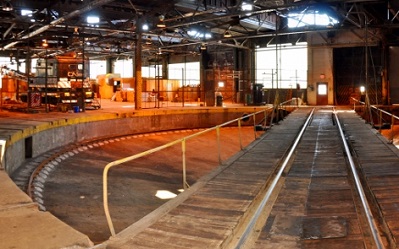Algoma Central Engine House National Historic Site of Canada
Sault Ste. Marie, Ontario

Engine House interior turntable
© Agence Parcs Canada/ Parks Canada Agency, 2018.
Address :
Near Carmen's Way and Wellington Street West, Sault Ste. Marie, Ontario
Recognition Statute:
Historic Sites and Monuments Act (R.S.C., 1985, c. H-4)
Designation Date:
1992-06-04
Dates:
-
1912 to 1912
(Construction)
Event, Person, Organization:
-
Algoma Central Railway
(Organization)
-
Arnold Company, Chicago
(Architect)
-
Arnold Company, Chicago
(Builder)
Other Name(s):
-
Algoma Central Engine House
(Designation Name)
Research Report Number:
1992-SUA Feb; 2019-CED-SDC-06
Plaque(s)
Existing plaque: On John Rowswell Hub Trail, near Wellington Street West, Sault Ste. Marie, Ontario
This engine house was built in 1912 by the Arnold Company of Chicago for the terminal of the Algoma Central and Hudson Bay Railway, which connected Sault Ste. Marie to the main line of the Canadian Pacific Railway. Originally used to maintain and overhaul steam locomotives, this massive, well-preserved structure was the first “square house” in Canada to have an interior turntable, providing access to its 14 radiating pit tracks. As a testament to the success of this design, the building has survived virtually intact, converting easily, with only a few alterations, to servicing diesel engines during the 1950s.
Description of Historic Place
The Algoma Central Engine House is a large, early-20th-century, brick engine house with an internal turntable. It is located in the Steelton Yard in Sault Ste. Marie. The formal recognition is restricted to the building and the enclosed turntable.
Heritage Value
The Algoma Central Engine House was designated a national historic site in 1992 because it is a remarkably well-preserved example of its type.
Built by the Algoma Central Railway in 1912 to provide maintenance and overhauls for steam locomotives, the Algoma Central Engine House was the first of only two engine sheds built to this design in Canada. It differed from other engine sheds in its massive scale and in its incorporation of a full-sized turntable, instead of parallel through-tracks.
The Engine House is almost completely intact, comprising an enclosed turntable; numerous stalls with pits; and an attached machine shop. Together with two flanking buildings of comparable size, construction, age and integrity, it dominates the rail yard.
Source: Historic Sites and Monuments Board of Canada, Minute, February 1992.
Character-Defining Elements
Key elements that relate to the heritage value of the Algoma Central Engine House include: its massive scale; its T-shaped plan, consisting of a large, rectangular engine house attached at right angles to a large, rectangular machine shop and accessed by double entry doors at opposite ends of the structure; construction materials used in the engine house, consisting of a vitrified brick floor laid in sand on a cement base, concrete foundations extending up the exterior walls to window sill height, brick walls with regularly spaced reinforcing pilasters, steel roof columns and trusses, and a wood sheath roof with composition roofing; the arrangement of openings along the engine house walls, consisting of a series of massive window openings set between the pilasters and anchored in brick; a four-course brick corbel projecting from the walls above the window openings; six monitor roofs running the length of the engine house, fitted with 1.2 metre continuous steel sash windows with original glazing; surviving asbestos smoke jacks; construction materials used in the machine shop, including reinforced cement-tile roof covered with roofing material, floor composed of creosoted, maple paving blocks laid in sand on a concrete sub-base, brick walls, and a single-pitch, steel roof truss; the interior configuration of the engine house, in which 14 locomotive pit tracks and four shorter stalls radiate from a central turn-table; the surviving intact enclosed turntable; the interior tracks in both engine house and machine shop; functional interior features of the machine shop, including two erecting pits with tracks leading from the engine house, and a perimeter industrial track with turn-tables giving access to machine shop bays, three small turntables providing access from the stalls of the engine house, a travelling crane supported on a girder above the floor, and an electric screw jack hoist for removing wheels from locomotives; its relationship to the two flanking buildings in the rail yard, the Stores Building and the Car Shops, both of similar construction and size and erected within the same time period.